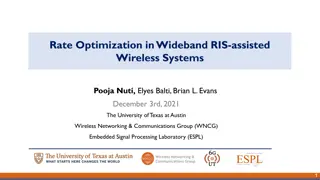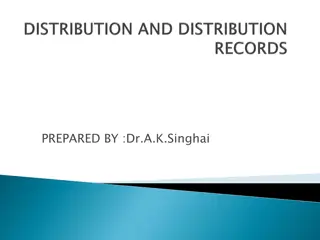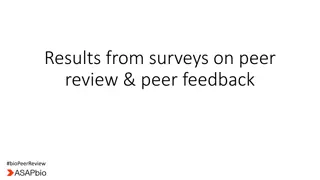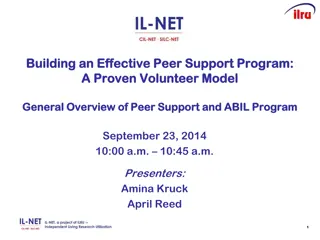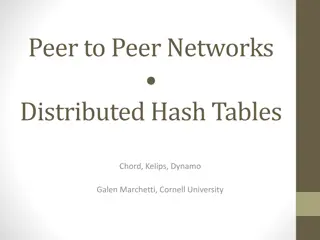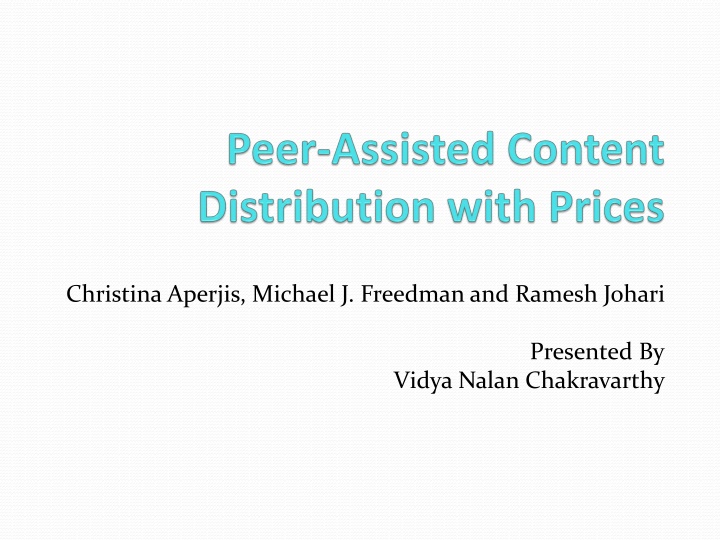
Multilateral Exchange System for Peer-to-Peer Content Sharing
Explore the role of prices in a multilateral exchange system for P2P content sharing, comparing it with bilateral exchange mechanisms. Discover how PACE enables efficient peer interaction and incentivizes contributions in decentralized networks.
Download Presentation

Please find below an Image/Link to download the presentation.
The content on the website is provided AS IS for your information and personal use only. It may not be sold, licensed, or shared on other websites without obtaining consent from the author. If you encounter any issues during the download, it is possible that the publisher has removed the file from their server.
You are allowed to download the files provided on this website for personal or commercial use, subject to the condition that they are used lawfully. All files are the property of their respective owners.
The content on the website is provided AS IS for your information and personal use only. It may not be sold, licensed, or shared on other websites without obtaining consent from the author.
E N D
Presentation Transcript
Christina Aperjis, Michael J. Freedman and Ramesh Johari Presented By Vidya Nalan Chakravarthy
Abstract Role of prices Price based multilateral exchange User Incentives Hierarchical network model PACE Peer Assisted Content Exchange Simulation Analysis Conclusions
Introduction P2P systems - Bit torrent Bilateral barter content exchange mechanism Problems Resource allocation Incentive mechanisms Bilateral barter Exchange between well-suited pairs Implicit encoded prices through rate reciprocation mechanism Slow stable peering Hard to find a good reciprocation Altruistic behavior critical to provide content availability
Multilateral Exchange System matches user demand with available supply at other peers in the network Explicit pricing Helps identify files to disseminate Identify location of resource congestion Useful content providers
Bilateral Vs Multilateral exchange Multilateral exchange Equilibrium exists Efficient under general conditions Robust to collusive behavior Bilateral Equilibrium fails to exist if exchange is restricted May be inefficient if it exists May fail to be robust to collusive behavior
PACE Effectively and practically realizes multilateral exchange Exchange currency using market based mechanism Single price per peer System specifies algorithmic buy and sell behavior Shield honest users and prevents malicious users from damaging system operation Gives incentives to contribute
PACE Features Price Management Decentralized to user clients Easily discoverable price information One price per peer Incentive Benefits Use of currency market power is transient
PACE Features Dynamic adaptation of resource constraints Identify network congestion Strong incentive to local transfers Uses explicit pricing Flexible
Pricing Pricing schemes for multilateral exchange 1. one price per peer (PP) 2. one price per file (PF) 3. one price per file per peer (PFP)
Pricing Comparing schemes through equilibrium or static settings PP is the most desirable PF,PP and PFP are equal if only upload capacity restricts transfers PF is worse than PP if network topology is non trivial PF and PFP yield equivalent equilibrium
Advantages of PP scheme Leads to simpler price dynamics Unpopular files with rare requests Serves requests sequentially without preemption
Dynamics Difficult to determine system s equilibrium prices or allocation in advance Need to consider dynamic issues Issues related to dynamics Peer discovery Price discovery Service discipline
Peer Discovery Faster peer discovery for explicit per-peer prices Long discovery time for implicitly priced systems E.g. Bit Torrent s rate based exchange ratios System performs a brute force search across peers
Price Discovery Update price of peers and links based on excess demand If demand > supply, increase price In PP scheme Demand = sum of all received rate requests Supply = upload capacity of access link In PFP, excess demand calculation is complex Excess demand for each file separately Supply is based on prices Optimal for peer to upload his most expensive file
Store and Exchange of currency Advantages Peers can trade before equilibrium prices are reached Reach rate allocation by decentralized trading Issues Complicated Exchange and credit balance need to be secured
PACE System design Multilateral exchange through Currency and Per-peer pricing scheme Peers and links are priced Peers requests download rates of other peers
PACE System design To download, peer pays Uploading peer and All the links traversed by its traffic Payment to links is rebated equally among peers Requests are served sequentially without preemption Prices are updated based on excess demand
User Incentives Efficient use of resources in large peer to P2P systems Users are given incentives To contribute high percentage of upload capacity To share high-value content Currency is stored over time Users are paid for delivered rates
User Incentives Network links are priced to reflect congestion Market Power Generally transient Market manipulation cannot increase profit Issue if few users have a file
Hierarchical Network Model Associating price with every link Infeasible due to 1. lack of network topology and routing information 2. inaccurate bandwidth estimation and 3. computational complexity Hierarchical model Prices bottlenecks restricting supply separately
Model Description Network is divided into local clusters Types of links Immediate (local) links Access links Transient congestion at access links Capturing rare bottlenecks
Constraints Nodes within a cluster share high capacity links Transmission across wide area involves shared, lower capacity access links
PACE client mechanisms Not directly exposed to end users Serves as algorithmic devices to ensure efficient exchange Exposes a simple interface to users Users software computes buy and sell behavior Mechanisms Buy client and Sell client
Sell Client User declares Files to upload Total upload capacity Sell client maintains two prices P0s, P1s Update Rule Demand > Supply => price increases Supply > Demand => price decreases
Pricing Scarce Resources Update P1s Demand = total requested download rate at remote buy client offering the least P1s Supply = upload capacity of access link of sell client Update P0s Demand = local requests + minimum of remote requests Supply = upload bandwidth on sell client of immediate link
Service Disciplines Requests are served in the order of arrival No incentives to queue requests per peer pricing
Buy Client User chooses Files of (Ti) to download Savings rate % of current balance saved for future use Steps : 1. order given sell clients (j) by total price 2. buy client spends budget committed 3. if j s upload capacity is exhausted, move to next sell client 4. budget exhausted - buy client stops 5. unused budget is split between files(Ti - f) evenly
Buy Client Tradeoff between user s experience and personalizing utility function Simplicity Vs descriptive power
PACE functionalities Resource discovery 1. 2. Network friendliness 3. User management 4. Transactions and currency security
PACE Architecture Trade content for virtual currency Rendezvous service Network price service Centralized currency mechanism Secures transactions and currencies Logically separate services Rendezvous is file specific Banks are currency specific Network prices are independent of files and currency
Resource and Price Discovery Rendezvous service stores single prices Input to rendezvous service File identifier Buy client information Output to rendezvous service set of IP addresses with minimal cost Determine latest prices Allocate budget and prioritize transfers
Network Friendliness Avoid expensive network links For wide area traversal, network price is added to Ps Methods to determine network prices 1. using third party service 2. explicit ISP input Rendezvous service and network service may be: 1. loosely coupled 2. tightly coupled
Managing Users Collusion PACE is robust to collusion (consequence of multilateral exchange) Aggregate wealth of clients cannot increase by combining trade Bootstrapping new users Grant money upon joining or Ability to download for free
Managing Users User registration Protect against sybil attacks PACE maintains currency as stored value Bootstrapping occurs only at start and not at every transfer
Securing Transactions Security through logically centralized banks Exchanges should be fair Buy client pays for content received Sell client receives payment with an of content transmitted for the agreed price
Securing Transactions Failure during the transaction after i/kth of content transfer and = 1/k, buy client pays [(i-1)/k] * P <= P <= [i/k] * P Clients cannot Forge system currency Spend more than the current balance
Securing Transactions At the beginning of transfer Buy client b send cryptographic signature and certified public key to s for verification To deposit payment Bank verifies of b and checks for replay then it checks the cryptographic hash Proceeds with the transaction double-entry book keeping One signature verification One cryptographic hash
Securing currency and balances Logically centralized banks are easily scalable Currency is virtual PACE uses local banks to aggregate local transactions and reduce load
Securing currency and balances Content provider acts as Bank to manage currency and User registration authority Public/Private key pairs identify users Signed certificate is issued to new user Bank refreshes certificates of active clients For each registered user, bank stores 1. hash of its public key 2. current balance 3. counter clast
Securing currency and balances Preventing deposit replays Ct > Clastof buy client If deposit succeeds, Clastis set to Ct Preventing overdraw on accounts Minimize aggregation of payments Minimize buy client s certificate expiry time Sell client performs online check at start Negative balance is penalized
Simulation Analysis - I File prices reflect resource constraints Local links are cheaper than remote links Once chunks are disseminated, local prices drop
Simulation Analysis - II Contributing upstream capacity improves user s performance Non free loaders download chunks faster than free loaders
Simulation Analysis - III Local transmissions are preferred over remote in PACE Bit torrent makes poor use of locality



